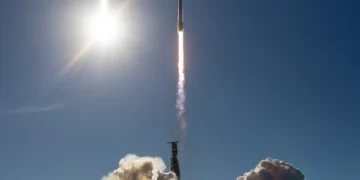In a remarkable breakthrough that could revolutionize how rescue missions are conducted in disaster-stricken areas, Australian scientists have successfully developed and tested ‘cyborg beetles’—real insects equipped with miniature electronic backpacks that allow researchers to remotely control their movements. These hybrid creatures could one day become essential allies in search-and-rescue operations, particularly in environments like collapsed buildings or landmine fields where traditional robots struggle to navigate.
The groundbreaking study, conducted by a team of researchers at the University of Queensland, demonstrates how biological and technological systems can be combined to create innovative solutions for challenges in disaster response, urban search missions, and even military applications.
The Concept of Cyborg Insects: Blending Biology with Robotics
The term “cyborg beetle” refers to a biologically intact beetle fitted with a tiny electronic control system that interfaces with the insect’s nervous system to direct its movements. These beetles retain full mobility and functionality while carrying a lightweight, detachable backpack-like device containing microcontrollers, sensors, and wireless transmitters.
Dr. Thieng Wu-Duan, the lead researcher from the University of Queensland, explained that the technology uses electrodes to stimulate the beetle’s antennae and forewings, giving the operator precise control over the insect’s direction and motion. The team used a standard video game controller to issue commands to the beetle, enabling it to maneuver through complex terrains and tight spaces.
“We chose beetles because they possess natural skills that outperform even advanced robots in certain areas,” said Dr. Wu-Duan. “They are small, incredibly agile, and naturally adapted to traverse uneven or cluttered landscapes—perfect for exploring collapsed buildings or rubble.”
Why Beetles? Nature’s Natural Navigators
While robotic platforms have advanced significantly in recent years, their ability to navigate unpredictable terrain remains limited. In contrast, insects like beetles are evolutionarily designed to climb, crawl, and squeeze through narrow gaps—a capability that is almost impossible to replicate with synthetic machines of comparable size.
Key advantages of using beetles in rescue scenarios include:
- Superior agility and flexibility in tight, cluttered, and unstable environments
- Low energy requirements (as their biological systems power much of their motion)
- Minimal noise, making them less likely to disturb fragile structures or trigger secondary collapses
- Natural camouflage and resilience, enabling them to survive in hostile or hazardous environments
Beetles have also evolved highly sensitive antennae, which they use to detect changes in their environment—another feature that, when paired with sensors, could help detect human body heat, movement, or sound beneath rubble.
How the Cyborg System Works: The Technology Behind the Innovation
The electronic backpack developed by Dr. Wu-Duan’s team is a removable, non-invasive device that interfaces with the beetle’s nervous system via a series of electrodes carefully placed near its antennae and wings. The signals transmitted through these electrodes do not harm the insect but instead act as directional cues that guide the beetle left, right, forward, or even initiate flying.
The system includes:
- A microcontroller to process commands
- Wireless communication module for remote operation
- Battery with ultra-low power consumption
- Tiny electrodes that deliver precise electrical impulses
- Optional sensor add-ons, such as cameras, microphones, or heat sensors
“We’ve designed the system so it’s lightweight and detachable, causing no permanent change or injury to the beetle,” Dr. Wu-Duan emphasized. “Our priority was ethical engineering that respects the life of the insect while harnessing its natural strengths.”
The entire setup is light enough for the beetle to carry without affecting its movement or lifespan, and once the mission is over, the backpack can be safely removed, allowing the beetle to return to its natural environment.
Applications in Disaster Zones and Minefields
The cyborg beetles could serve as first responders in environments that are too dangerous or inaccessible to humans or robots, such as:
- Collapsed buildings after earthquakes or bombings
- Urban disaster zones following structural fires or explosions
- Post-war areas riddled with landmines or unexploded ordnance
- Search missions in dense forests or jungles
In such cases, human rescue teams often face life-threatening risks while trying to reach survivors. Traditional robots may struggle due to size, weight, limited battery life, or lack of dexterity. In contrast, cyborg beetles can safely scout these areas, transmit real-time data, and pinpoint the location of trapped individuals using built-in sensors.
This capability could potentially save precious time during the “golden hours” after a disaster, when swift action can make the difference between life and death.
Ethical Considerations: Balancing Innovation and Animal Welfare
As with any research involving living organisms, the creation of cyborg beetles has raised ethical questions regarding animal welfare and the treatment of insects in scientific studies. Dr. Wu-Duan’s team took several precautionary steps to ensure that the beetles were not harmed, subjected to pain, or altered permanently.
The electrodes used are non-invasive, and the beetles exhibited no signs of stress or behavioral changes after the removal of the device. The research protocol was reviewed and approved by an ethics committee, and the team is also developing automated deactivation systems that allow the beetle to regain full autonomy after a set mission duration.
Limitations and Future Challenges
While the results are promising, there are several challenges that researchers must address before cyborg beetles can be deployed in real-world disaster scenarios:
- Range limitations: Current wireless systems may only work within a certain distance; future versions may require satellite or long-range communication modules.
- Battery constraints: Ultra-miniature batteries still limit the operating time of the devices.
- Data transmission: Sending video or complex sensor data in real time from inside rubble poses technological hurdles.
- Environmental factors: Harsh conditions such as extreme temperatures, dust, or radiation may affect performance.
Despite these challenges, the research has opened new frontiers in the field of biohybrid robotics, demonstrating that biologically assisted machines can outperform purely mechanical systems in many scenarios.
Looking Ahead: The Future of Bio-Robotics and Rescue Technology
Dr. Wu-Duan’s research is part of a broader global effort to explore bio-hybrid systems, where living organisms and machines work together to overcome technological limitations. Scientists around the world are experimenting with cyborg cockroaches, moths, and even rats for tasks ranging from surveillance to search and rescue.
The next phase of the project will involve:
- Equipping beetles with heat or chemical sensors to detect human presence
- Miniature camera integration to provide visual feedback from disaster zones
- Swarm technology, allowing multiple beetles to work together and map environments more effectively
If successfully scaled, cyborg beetles could become a vital part of emergency response toolkits, particularly for nations prone to natural disasters or conflicts.
Conclusion: Small Insects with Big Impact
The development of cyborg beetles marks a significant milestone in bioengineering and robotics, proving that nature-inspired innovation can offer practical solutions to some of humanity’s most pressing challenges. By merging the innate abilities of insects with modern technology, scientists have created a tool that is affordable, effective, and environmentally sustainable.
As research progresses and technology becomes more sophisticated, cyborg insects could play an increasingly critical role in saving lives, mapping dangerous terrains, and expanding our understanding of how biology and technology can harmoniously coexist.
What may seem like science fiction today could soon become a standard practice in disaster management—all thanks to the humble beetle.

























